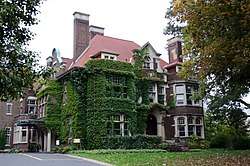East Avenue Historic District
|
East Avenue Historic District | |
 The Strong-Todd House on East Avenue | |
  | |
| Location | Irregular pattern along East Ave. from Probert St. to Alexander St., Rochester, New York |
|---|---|
| Coordinates | 43°9′9″N 77°34′51″W / 43.15250°N 77.58083°WCoordinates: 43°9′9″N 77°34′51″W / 43.15250°N 77.58083°W |
| Area | 362 acres (146 ha) |
| Architect | Wright, Frank Lloyd; Et al. |
| Architectural style | Greek Revival, Italianate, Queen Anne |
| NRHP reference # | 79001589[1] |
| Added to NRHP | April 17, 1979 |
East Avenue Historic District is a national historic district located at Rochester in Monroe County, New York. The district consists of a series of large 19th and early 20th century homes, houses of worship, meeting houses, and museums. It contains approximately 700 structures. Notable structures in the district include the Hiram W. Sibley House (1868), home of Hiram Sibley; Edward E. Boynton House (1909), Rochester's only work by Frank Lloyd Wright; the Culver House (1805–1816), moved to its present site in 1906; and the Strong-Todd House (1901), once occupied by Henry A. Strong.[2]
It was listed on the National Register of Historic Places in 1979.[1]
The George Eastman House is a National Historic Landmark located within the district.
Gallery
 The Hiram Sibley House at 400 East Avenue
The Hiram Sibley House at 400 East Avenue Stone fencepost at the street entrance to the Hiram Sibley House
Stone fencepost at the street entrance to the Hiram Sibley House The Culver House at 70 East Boulevard
The Culver House at 70 East Boulevard
References
- 1 2 National Park Service (2009-03-13). "National Register Information System". National Register of Historic Places. National Park Service.
- ↑ Margaret L. Nadler (December 1976). "National Register of Historic Places Registration: East Avenue Historic District". New York State Office of Parks, Recreation and Historic Preservation. Retrieved 2009-09-01. See also: "Accompanying 79 photos". and "Accompanying photo captions".
External links
All of the following Historic American Buildings Survey (HABS) records are filed under Rochester, Monroe County, NY:
- HABS No. NY-5-R-5, "Oliver Culver House, 70 East Boulevard", 4 photos, 10 measured drawings, 3 data pages
- HABS No. NY-5-R-7, "Silas O. Smith House, 485 East Avenue", 2 photos, 12 measured drawings, 3 data pages, supplemental material
- HABS No. NY-5639, "Bates-Ryder House, 1399 East Avenue", 6 photos, 9 data pages
- HABS No. NY-5640, "Charles Bissell House, 666 East Avenue", 4 photos, 9 data pages
- HABS No. NY-5645, "George Thompson House, 546 East Avenue", 5 photos, 8 data pages
- HABS No. NY-5648, "Hiram W. Sibley House, 400 East Avenue", 5 photos, 7 data pages, supplemental material
- HABS No. NY-5655, "E. E. Boynton House, 16 East Boulevard", 7 photos, 11 data pages

